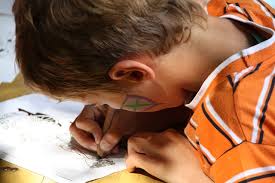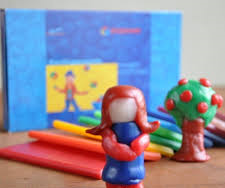What a strange pencil grip!
Oct 18, 2014
Should I change my child's pencil grip? This is such a complex question. And it is an area that OTs explore in great detail.

The anonymous OT gives a great breakdown of how an OT considers a child's pencil grip in the context of their overall pencil skills. But right now you have a child in front of you and they are holding their pencil in the strangest fashion... and you want to know if you should change it and how you can change it.
Well first of all, trust your child. Research has shown that simply changing a child's pencil grip doesn't seem to impact on handwriting speed or legibility. And if you start paying attention to the pencil grips you see adults use around your daily life, you'll see that a very wide range of unusual grasp patterns are used by adults who are able to write functionally and well. So, as a general rule of thumb, it's not so much how a child holds their pencil, but it's more important how well they can control the pencil.
How can you encourage your child to develop their pencil control? Here are a few simple tips:
1. Draw with small pieces of broken chalk or broken crayon. This requires the child to use their finger tips only to control the drawing tool.
2. Doodling patterns are fun to decorate drawings.
3. Colouring in is actually a great pencil control activity. If a child is frustrated with the quality of their work you can outline the edge with a really thick nikko. Or to make it a fun activity with some tactile feedback you can outline the edge with aquadhere glue.

4. Strengthen the finger tips. My favourite medium is Steiners Modelling Wax. It is resistive so children are required to work hard for their results. Steiner schools use it instead of playdough to build strong fingers. It is reusuable and lasts well. I prefer it to the theraputty that OTs traditionally use as it is made of beeswax. So it has a natural feel and mild honey scent. And it can help children concentrate while listening to a story, or listening during a class teaching session. I have to admit I absolutely love the feel of the wax myself and love making little creations.
5. Holding a small rubber in the palm of your hand with the ring and little fingers while drawing or writing. This helps the child stabilise the little finger side of the hand, as part of developing pencil control is learning to have very fine movement with the thumb side, while the little finger side stays still.
Sometimes it is helpful for an OT to come and have a look, as we are trained in detailed observation of all aspects of handwriting and pencil control. Specific activities can help develop particular movements, or overcome specific challenges with writing and pencil control.
In the meantime, with fun activities and a supportive environment your child's pencil control skills will be encouraged to blossom...
How to make drawing and writing fun for a child who hates it.
Would it help my child to sit on a worm bOble when they do their writing and drawing?
Disclaimer
The information, including but not limited to text, graphics, images, and other material contained on this website are for informational purposes only. This website is not intended to be a substitute for professional medical, healthcare or educational advice, diagnosis, or treatment. Always seek the advice of a qualified healthcare provider for any questions you may have regarding you or your child’s health concerns, and never disregard professional medical advice or delay in seeking it because of something you have read on this website.
blog comments powered by Disqus
